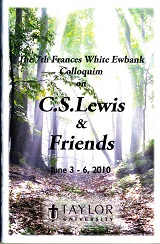Event Title
Academic Paper Session IV-A
Location
Rupp 203
Start Date
5-6-2010 3:00 PM
Description
"So Old and So New: Memory and Expectation in the Fantastic Works of C.S. Lewis & J.R.R. Tolkien" - Megan J. Robinson
For both C.S. Lewis and J.R.R. Tolkien, the realms and stories of Faërie and the fantastic, in addition to being entertaining were revelatory: insights about the very nature of Reality come through the images and narratives of these secondary worlds, in which the perception of time often plays a major role. Examining such issues as time and ultimate reality in Lewis’s and Tolkien’s works must take into account each author’s devout and profound Christian faith, oriented around the eucatastrophe of the Gospel message radiating backwards and forwards throughout human history. This faith thus shaped how they understood the past, present, and future: Tolkien looked backward and Lewis forward. In The Chronicles of Narnia, and The Space Trilogy, and Lord of the Rings and The Simarillion, each author worked within these theological boundaries in the “Primary World”, believing that he was drawing upon, as well as revealing, Reality in creating as he did. St. Augustine’s meditation on the perception of time as memory and expectation frames this exploration of Lewis and Tolkien’s understanding of the relationship between faith and Faërie, leading, as always, “further up and further in.”
"Reader and Writer: Lewis and Tolkien 'On Fairy-Stories'" - Elizabeth Coon
Although J.R.R. Tolkien’s reputation in recent years has benefited immensely from Peter Jackson’s film productions of The Lord of the Rings, C.S. Lewis still far outreaches him in terms of public awareness and popularity, specifically within the Christian world. Most are surprised to learn that Tolkien played a major role in Lewis’ conversion, rather than vice versa, and that their famous friendship did not continue indefinitely, but began to fade with the publication of Lewis’ The Chronicles of Narnia. The differences in their philosophies of storytelling unsurprisingly reveals the philosophy of their relationship. In “On Fairy-Stories,” Tolkien demands that fantasy worlds remain independent and consistent, receiving no interference from the author’s own world. Lewis blatantly ignores that rule in Narnia by combining all kinds of mythology and sending human children back and forth between England and Aslan’s world. Rather than regard these differences as the final breach between the two authors, condemning their stories to suffer literary history with no comparisons or connections made, scholars must instead recognize and utilize them in an understanding of Lewis and Tolkien’s relationship as eager participant and proud creator, as reader and writer.
"The Shieldmaiden of Rohan" - Hannah Woodard
This paper explores the origin and purpose of one of Tolkien’s most highly debated characters: Eowyn. I have examined Eowyn from multiple angles, taking into consideration Christian, feminist, and literary perspectives, as well as considering her medieval origins. Tolkien synthesizes all of these factors into a strong female character who represents a larger theme of his work, the triumph of paradoxical power which comes through humility and gentleness. Eowyn’s inner struggle is illuminated particularly by her relationships with both Aragorn, who represents power and renown, and Faramir, who represents restraint and humility. Her final acceptance of her femininity and strength as a woman is achieved largely through the intervention of Faramir, who helps her to understand her heart.
Event Type
Paper
Academic Paper Session IV-A
Rupp 203
"So Old and So New: Memory and Expectation in the Fantastic Works of C.S. Lewis & J.R.R. Tolkien" - Megan J. Robinson
For both C.S. Lewis and J.R.R. Tolkien, the realms and stories of Faërie and the fantastic, in addition to being entertaining were revelatory: insights about the very nature of Reality come through the images and narratives of these secondary worlds, in which the perception of time often plays a major role. Examining such issues as time and ultimate reality in Lewis’s and Tolkien’s works must take into account each author’s devout and profound Christian faith, oriented around the eucatastrophe of the Gospel message radiating backwards and forwards throughout human history. This faith thus shaped how they understood the past, present, and future: Tolkien looked backward and Lewis forward. In The Chronicles of Narnia, and The Space Trilogy, and Lord of the Rings and The Simarillion, each author worked within these theological boundaries in the “Primary World”, believing that he was drawing upon, as well as revealing, Reality in creating as he did. St. Augustine’s meditation on the perception of time as memory and expectation frames this exploration of Lewis and Tolkien’s understanding of the relationship between faith and Faërie, leading, as always, “further up and further in.”
"Reader and Writer: Lewis and Tolkien 'On Fairy-Stories'" - Elizabeth Coon
Although J.R.R. Tolkien’s reputation in recent years has benefited immensely from Peter Jackson’s film productions of The Lord of the Rings, C.S. Lewis still far outreaches him in terms of public awareness and popularity, specifically within the Christian world. Most are surprised to learn that Tolkien played a major role in Lewis’ conversion, rather than vice versa, and that their famous friendship did not continue indefinitely, but began to fade with the publication of Lewis’ The Chronicles of Narnia. The differences in their philosophies of storytelling unsurprisingly reveals the philosophy of their relationship. In “On Fairy-Stories,” Tolkien demands that fantasy worlds remain independent and consistent, receiving no interference from the author’s own world. Lewis blatantly ignores that rule in Narnia by combining all kinds of mythology and sending human children back and forth between England and Aslan’s world. Rather than regard these differences as the final breach between the two authors, condemning their stories to suffer literary history with no comparisons or connections made, scholars must instead recognize and utilize them in an understanding of Lewis and Tolkien’s relationship as eager participant and proud creator, as reader and writer.
"The Shieldmaiden of Rohan" - Hannah Woodard
This paper explores the origin and purpose of one of Tolkien’s most highly debated characters: Eowyn. I have examined Eowyn from multiple angles, taking into consideration Christian, feminist, and literary perspectives, as well as considering her medieval origins. Tolkien synthesizes all of these factors into a strong female character who represents a larger theme of his work, the triumph of paradoxical power which comes through humility and gentleness. Eowyn’s inner struggle is illuminated particularly by her relationships with both Aragorn, who represents power and renown, and Faramir, who represents restraint and humility. Her final acceptance of her femininity and strength as a woman is achieved largely through the intervention of Faramir, who helps her to understand her heart.


